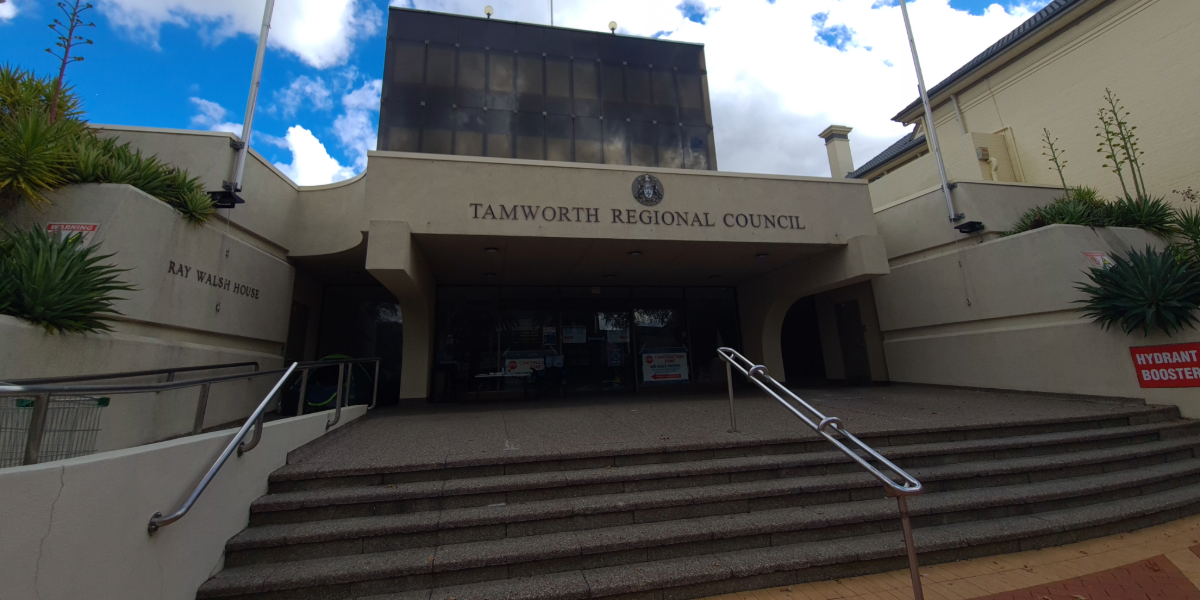The refurbishment of Tamworth Regional Council’s Ray Walsh House is looking increasingly unlikely after a recommendation by TRC General Manager Paul Bennett it would be both less expensive, and more sustainable in the long term to build new premises for TRC administration staff.
A summary of the report was submitted as part of the May 28 Council Meeting Agenda, and in it, it was found that the cost of renovation would be approximately double that of adding it to the future Performing Arts Centre, and that Ray Walsh House had reached the end of its 50-year lifespan.
Council decided at the meeting not to remediate the building for council staff, but did not make any judgements on whether it would be demolished or sold.
The asbestos is in the form of friable Chrysotile fireproofing applied to the building’s steel beams, a common practice in the 1970s when Ray Walsh House was built.
Tamworth Regional Council did not respond to questions asked by the New England Times if anyone had been exposed to the asbestos.
In a statement in February this year, Mayor Russell Webb said “When asbestos was discovered in the building we knew it would not be a quick fix.
“Both Council and our community would like to see this resolved sooner rather than later but we also know we need do it right.”
While not normally a problem if undisturbed, the failure of the air conditioning system on three of the five floors in 2022 meant that repairs could not be carried out without, as GM Bennett stated in a report to Council, “unacceptable risk”.
This resulted in the exodus of staff from the building. While some remediation works had been undertaken in 2023 to remove things like marble tiles from the reception, further work was halted after consultation with Safework NSW.
Remediation works would mean having to bring the 1970s-vintage Brutalist building into line with modern building standards, including major changes to accessibility and parking lot height, as well as major structural repairs needed for a building of its age.
Even with such repairs, the extended lifespan of the building and cost to ratepayers would be unknown, the report stated, and depreciation would be significant compared to a new build.
A new build, as added on to the Performing Arts would result in larger, custom-built spaces for Council staff, compliance with building standards, and a more sustainable building.
It would have less depreciation and a longer lifespan, but in the “medium term” of up to ten years interim accommodation for staff would have to be found.
The cost of a new build added on to the PAC would be $31,090,800, according to a quantity survey hired by Council, compared to $64,580,000 for the compliant renewal of Ray Walsh House.
There have been calls for saving Ray Walsh House, with Tamworth Regional Residents and Ratepayers Association leading the charge with their “Save Ray Walsh House” campaign.
Numerous letters to council and the press by the TRRRA have outline the building’s architectural significance, as well as questioning the costs of a new council building.
TRRRA claims that $2 million has been spent on the removal of internal walls and floors, and that “many historical artefacts” have been disposed of as waste.
Council claims that the amount paid to $900,000 to local business Rice Construction Group for the minor remediation works undertaken.
TRRRA claims that Ray Walsh House represents a $50 million asset that Council has written down to $28 million, and that Council has already started talks with property developers to by the building, as well as with CBD property owners to rent premises for staff.
A report on heritage buildings prepared for Council in 2017 argued for a heritage protection zone in Peel and Fitzroy streets, including the protection of Ray Walsh House as a great example of Brutalist architecture.
Both Tamworth Regional Council and TRRRA were approached for comment. TRRRA did not respond, while TRC pointed to the Council Meeting Agenda of the 28th of May, with a spokesperson saying that “The documents to be made public for scrutiny have not yet been collated and published”.
Like what you’re reading? Support The New England Times by making a small donation today and help us keep delivering local news paywall-free. Donate now

